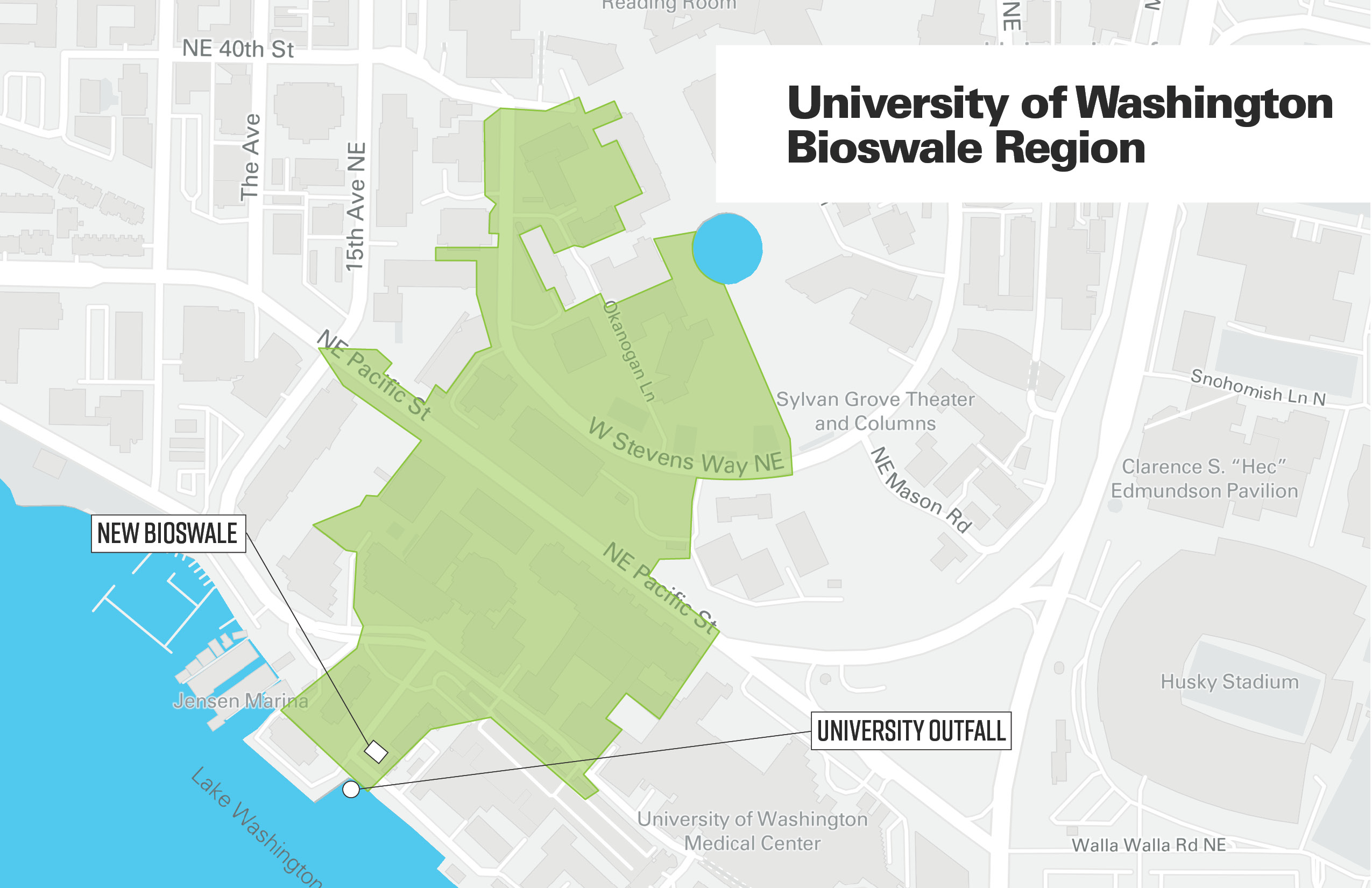Looking out over Lake Washington, it’s easy to assume that the waterways in our beautiful city are clean. It is also easy to overlook the signs that dot the edges of the shoreline, warning of temporary pollution during rainstorms.
For the most part, the waterways are clean, but sometimes the infrastructure that filters the City’s pollution and protects our beloved waterways is lacking—especially when it comes to the harsh pollutants lining our streets. This occurs anytime it rains—as it often does in the Seattle area—putting our ecosystems at risk and causing less-than-desirable pollution events for the city. When it rains, any water that touches the streets, cars and buildings collects the particles and pollutants that sit on those surfaces before flowing into storm drains and right back out into the lake through outfall pipes.
As part of their long-term goals of sustainability and responsible environmental stewardship, the University of Washington is already taking extensive measures to clean stormwater runoff from their campus before it flows into the bay. Many of their long-term goals for their future campus focus on improving the local environment, maximizing limited resources and encouraging innovation as they expand and build. During the development of the new Health Sciences Education Building (HSEB), the University had a unique opportunity to achieve those goals.

As part of the HSEB project, the interdisciplinary Progressive Design-Build Team of Miller Hull, Lewis, KPFF, and GGN had an idea to implement an innovative Green Stormwater Infrastructure (GSI) facility at the shore of the campus. The University’s planning and project delivery leaders thoughtfully supported this idea, taking into consideration its potential benefits to both the campus and the city. Upon completion, the GSI reduces the pollution from paved areas introduced to Portage Bay within a 34-acre stormwater drainage basin that a portion of the campus sits on.
What makes this project even more unique is the innovative approach the team took to repurposing the existing water holding facility, expanding the water treatment impact of the HSEB project site to go beyond its single-acre physical footprint. In most cases, traditional approaches to meet stormwater management requirements result in extensive excavation, infrastructure, installation and high associated costs. These solutions only treat the water runoff on their building’s site, cleaning it before letting it reenter the original stormwater infrastructure.
The GSI at HSEB takes a more holistic approach to water treatment. Built within an existing, out of commission hydraulic flume, this new facility will reuse the existing concrete flume to build an infrastructure within to remove pollution from the entire basin itself rather than just the one-acre HSEB site. While the GSI may have a relatively small footprint, its operation has a positive impact on the entire 34-acre drainage basin (as shown above in green) as well as the community at large.
Because of the capacity of this facility, its ability to remove solids effectively, and its downstream location within the basin, it is anticipated to replace onsite stormwater management requirements for future development on 17 acres of campus within the drainage basin. On top of that, it recycled the existing concrete flume, reducing construction waste.
Water moves through the existing infrastructure of the basin until just above Portage Bay, where the team installed a flow splitter to reroute stormwater into the new GSI. Once the stormwater enters the new system, it flows through a hydrodynamic separator that removes solids like leaves and trash to prevent the bioswale from flooding, then is pumped up into the swale itself to be cleaned.
The flume-turned-swale is filled with a highly engineered stratum of compact fill, gravel, soil and plants to filter the water as it passes through it—not unlike the way a water filter cleans your tap water. Once the cleaned water exits, it flows back out of the original outfall into Portage Bay, safer for the salmon and the bay ecosystem at large.
The University’s up-front investment in this added infrastructure is intended to treat more runoff immediately while saving on stormwater management costs on future projects. Originally, the HSEB scope or budget did not include this regional GSI. However, motivated by the incentivized Progressive Design-Build delivery that the University used for the HSEB project, the team was encouraged to think outside of the box to create greater value.
The incentivized risk-reward team of Lewis, Miller Hull, KPFF, and GGN determined that if they were able to squeeze waste out of the delivery process and mitigate risks as a team, unneeded contingency funds could be freed up and reinvested into the GSI—expanding the project’s impact beyond its site.
The result of the team’s efforts is this miniature treatment facility that takes advantage of basic filtration principles to allow the University to accelerate its timeline of increased sustainability and continue improving the environment of the community. From a public perspective, this GSI will allow Seattleites and students alike to continue to swim, paddle and row across the Cut without the fear of road pollution, while fish and wildlife are better protected. Thanks to the team and the UW, we can continue taking pride in the lake that is such an integral part of our City.

